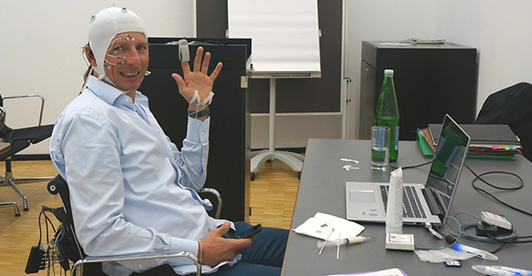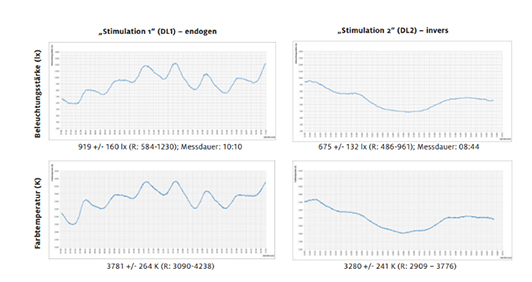
Light is constantly providing new images and releasing emotions. It controls physical processes and affects the biological clock. Dynamic across space and time, artificial lighting supports the naturally merged interplay of humans and nature. The immense diversity of lighting moods adapts to individual needs, architecture and activities over the course of time. Hereby, an illuminance that goes beyond normative standards and is controlled with the support of dynamic lighting colours provide added value for well-being, as the findings of the latest study show.
» Click here for the “Perceived lighting quality in the office” study
These findings lead to Zumtobel product innovations such as the new generation of MILD LIGHT with a planning approach of alternatively 500 lx or 800 lx illuminance. The tunableWhite technology was also more strongly integrated in new product developments so that the lighting colours can be optimally adapted to one’s needs and the time of day. Well-being increases with a change in lighting as well as concentrated working and communication. Quality of sleep, attentiveness and performance can also be improved with this innovative technology.However, the Fraunhofer IAO Study is based on the subjective documentation of the perception of lighting quality. Based on these classically established findings, the Nymphenburg Group from Munich conducted an office study by means of psychophysiological measurements. A new bioadaptive lighting concept in comparison to standard office lighting was investigated. The neuroscientific tool “Limbic Emotional Assessment” (LEA) was deployed and the control room featured 500 lx at 4000 K. With identical room conditions, 800 lx and interchanging light colours of 3,000 K (warm-white) to 6,000 K (daylight white), the six psychophysiological indicators all improved. In the dynamic setting with a higher illuminance, the participants were, for example, able to deal with stress better and were calmer. They were able to complete concentration tasks more reliably and more concentrated because they were more relaxed. Overall, the participants exhibited a better activation level with the bioadaptive lighting.
» Click here for the “Bioadaptive lighting” study

Similar findings were revealed by a field study conducted by scientists from Graz with 36 participants in two offices of Siemens and the LKH Weiz hospital (Austria) between October and March. This showed the significant influences of artificial lighting on the long-term stabilisation of the biological clock and the well-being of working people. High illuminance and a natural and dynamic course of intensity and light colours are recommended. Bright artificial lighting, which dynamically follows daylight conditions and therefore adapts to the natural surrounding conditions, has a more stabilising and supportive effect on humans in the long term. The study examined the effects of lighting on heart function, hormones, well-being, biological rhythms and sleep quality.
The following significant effects of office lighting were recorded in the field study: The chosen dynamic light situations (DL1 & DL2) with higher illuminance (ca. 800lx) were subjectively preferred in comparison to the static lighting with normative illuminance. When the heart frequency was monitored, it could be seen that a higher light intensity led to stronger activation when awake and this is associated with deeper sleep and improved stabilisation of our inner clock.
» Click here for the “Effect of lighting on the workplace” study

Image: The two examined courses of lighting development of the study on the effect of dynamic lighting solutions at the workplace. Reference condition: static.
An analysis of the data of the specialist literature by the Graz experts showed that time-related dynamic lighting control with higher intensity between 500 and 1,200 lx also has considerable benefits for employees.
Active Light by Zumtobel brings the dynamic of daylight inside – into the office – supports the natural biorhythm and improves well-being and satisfaction. The concept is able to provide the right lighting in the right intensity and colour at the right time. It also increases one’s concentration ability and people’s ability to deal with stress in daily life.
This implicitly leads to a more agreeable work climate, increased performance and a perfect work-life balance.
» Find out more about this on our special office page
Zumtobel. The Light.
